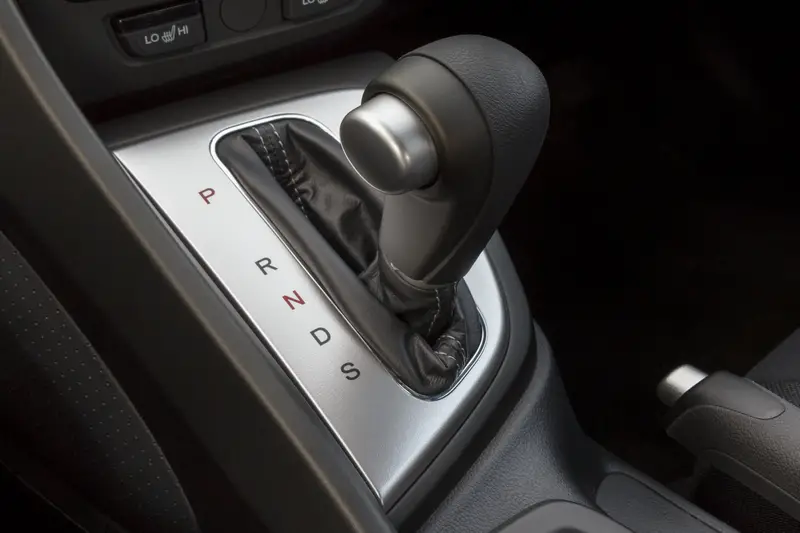Many of us have driving habits we don’t think twice about, like shifting to neutral at stoplights or when coasting downhill. What if I told you these seemingly harmless actions could be slowly destroying your car? Car owners often pick up these habits from friends or family without realizing the potential damage they’re causing to their vehicle’s transmission system—a repair that can easily cost thousands of dollars. Let’s look at what really happens when you put your car in neutral at the wrong times.
Shifting to neutral at stoplights damages your transmission
You’ve probably seen other drivers do it or maybe you do it yourself—shifting to neutral when stopped at a red light. Many drivers think this saves gas or reduces wear on the transmission, but this common habit is actually doing the opposite. Every time you shift between drive and neutral, your transmission components experience unnecessary wear. The transmission system is designed to operate most efficiently when in drive mode, with the engine providing proper lubrication and pressure throughout the system.
When you shift to neutral, you disrupt these carefully calibrated systems. The repeated action of shifting back to drive when the light turns green causes heat buildup in your transmission fluid and puts stress on components that weren’t designed for frequent shifting. Experts actually recommend keeping your vehicle in drive during normal operation, including brief stops at traffic lights. The small amount of fuel you might save is far outweighed by the potential cost of transmission repairs down the road.
Parking your car in neutral can lead to accidents
One of the most dangerous things you can do is leave your car in neutral when it’s parked. This removes a critical safety feature designed to keep your vehicle stationary. When you park a car with an automatic transmission, putting it in “park” engages a device called a parking pawl, which physically locks the transmission output shaft. If you have a manual transmission, leaving it in first gear or reverse provides similar protection. Without these safeguards, your car is being held in place by just the parking brake alone.
What happens if that parking brake fails? Your car could roll away, potentially causing property damage or even injuring someone. Even if you think you’re parked on perfectly flat ground, there may be a slight incline you can’t see. Strong winds can even push a vehicle that’s in neutral. Another scenario to consider: if another car bumps into your parked vehicle, the impact could disengage the parking brake, creating a dangerous runaway situation. Always use both safeguards together—park/gear and the parking brake—to create a failsafe system where if one fails, the other will still prevent your car from moving.
Coasting downhill in neutral reduces your control
Some drivers shift to neutral when going downhill, thinking they’re saving fuel. This dangerous practice actually removes a critical safety feature called engine braking. When your car is in gear, the engine helps slow the vehicle when you take your foot off the gas pedal. This natural braking effect helps maintain a safe speed and reduces wear on your brake pads. When you shift to neutral on a hill, you’re forcing your brakes to do all the work of controlling the car’s speed, which can cause them to overheat on long descents.
Overheated brakes lose stopping power—a terrifying situation when you’re heading downhill. Modern fuel-injected cars are designed to cut fuel delivery when coasting in gear downhill, so you’re not even saving gas by shifting to neutral. In fact, most newer vehicles use less fuel when engine braking in gear than when idling in neutral while coasting. Beyond the fuel efficiency issue, you’ll have reduced control in emergency situations, as shifting back to drive takes precious time when you need to accelerate quickly to avoid a hazard. Keep your car in gear when going downhill—your brake pads and safety will thank you.
Revving the engine in neutral causes unnecessary wear
We’ve all heard someone rev their engine loudly at a stoplight. Beyond being annoying to everyone around you, revving your engine while in neutral can cause serious damage to your vehicle. When you rev in neutral, the engine spins up much faster than it would under load, causing rapid temperature changes that put stress on internal components. The oil pressure system might not keep up with these sudden revs, potentially leaving critical parts without proper lubrication for short periods.
This practice is especially harmful to older vehicles or those with high mileage. The sudden pressure changes from revving can damage gaskets and seals that may already be weakened from years of normal use. Even in newer cars, unnecessary revving can accelerate wear on components like valve springs, piston rings, and bearings. The engine’s computer is programmed for optimal performance when the car is driven normally—not when it’s being revved randomly in neutral. If you want your engine to last, avoid the temptation to show off with needless revving. Your engine’s internal components will last much longer, saving you from expensive repairs down the road.
Neutral rolling saves no fuel and damages components
Have you tried “neutral rolling”—putting your car in neutral as you approach a stop to save gas? This habit might seem clever, but it’s actually counterproductive. Modern vehicles with fuel injection systems are designed to cut fuel delivery entirely when you’re coasting in gear with your foot off the accelerator. When you shift to neutral, however, the engine needs to keep using fuel just to keep idling. Not only are you not saving fuel, but you’re actually using more of it compared to staying in gear as you slow down.
Beyond the fuel waste, neutral rolling puts additional stress on your transmission. Each time you shift from drive to neutral and back again, you’re forcing the transmission to disengage and reengage. This repeated action causes premature wear on the shifting mechanisms and clutch packs inside the transmission. The transmission fluid heats up with each shift, which accelerates its breakdown and reduces its protective properties. The small amount of braking effort you save isn’t worth the potential damage to your transmission fluid and components. For both your wallet and your car’s longevity, it’s best to stay in drive until you come to a complete stop.
Switching between drive and neutral in traffic wears out parts
Stop-and-go traffic is frustrating, and some drivers constantly switch between drive and neutral during these situations. They might put the car in neutral when stopped, then shift back to drive when traffic moves forward again. This repeated shifting pattern puts enormous stress on your transmission. Each time you make this shift, the internal components must engage and disengage, creating friction and heat. These constant transitions accelerate wear on clutch packs, bands, and other critical parts inside your transmission.
Automatic transmissions are designed to remain in drive when stopped momentarily. The torque converter—a fluid coupling device—allows the engine to run while the car is stationary without stalling or putting stress on the transmission. When you keep shifting in and out of neutral during traffic, you’re overriding this clever design and creating unnecessary work for the transmission. The heat generated from these frequent shifts can break down transmission fluid faster, reducing its ability to protect internal parts. Transmission repairs are among the most expensive car fixes, often costing thousands of dollars. Save yourself this headache by keeping your car in drive during traffic jams, only shifting to park for stops lasting longer than 10-15 minutes.
Turning off your car while in neutral is risky
Some drivers have developed the habit of shifting to neutral before turning off the engine. While this won’t necessarily damage your engine or transmission directly, it creates a dangerous situation. When you turn off your car while it’s in neutral, you’re removing one of the key safety mechanisms that prevents the vehicle from moving unintentionally. If you forget to engage the parking brake or if it fails, your car could roll away—potentially causing damage or injury. This is especially dangerous if you park on any kind of incline, even one that seems very slight.
The proper procedure for parking an automatic transmission vehicle is to come to a complete stop, shift to park, and then turn off the engine. For manual transmissions, you should stop completely, engage first gear (or reverse if facing downhill), apply the parking brake, and then turn off the engine. These steps ensure your vehicle has multiple systems preventing it from rolling away. Modern vehicles often have safety features that require the transmission to be in park before the key can be removed, but older cars might allow you to remove the key in any gear position. Make it a habit to always shift to park before turning off your engine—it takes only a second but provides important protection against potential accidents and insurance claims.
Leaving your car in neutral during automatic car washes
Automatic car washes often instruct drivers to put their vehicles in neutral before the conveyor system pulls the car through. While this specific use of neutral is necessary and designed into the car wash process, there are still risks to be aware of. First, make sure you’re following the car wash attendant’s instructions exactly. Some modern vehicles with advanced safety features might interpret the car wash’s movements as a potential accident and engage emergency braking or other safety systems if not properly prepared.
When exiting the car wash, many drivers forget to shift back to drive promptly, leading to a moment of confusion when the car doesn’t move forward. In busy car washes, this can create backups or even minor fender benders if the driver behind you isn’t paying attention. Always shift back to drive immediately after clearing the end of the wash track. Also, be careful about shifting between gears when your car is still wet—water can sometimes enter through door seals when windows are lowered, potentially affecting electronic shifting systems in some vehicles. If you prefer to avoid these issues altogether, consider hand washing your car or using touchless car washes where you remain in control of the vehicle at all times, keeping it in drive throughout the process.
Your car’s transmission is one of its most complex and expensive components to repair or replace. By avoiding these harmful neutral-gear habits, you can significantly extend its life and save yourself from costly repairs. Modern vehicles are designed to function most efficiently when used as the manufacturer intended—which rarely includes excessive use of the neutral gear. Remember that the small conveniences or perceived benefits of these habits don’t outweigh the potential for serious damage to your vehicle or the safety risks they create. Treat your transmission with respect, and it will keep your car running smoothly for many more miles.

